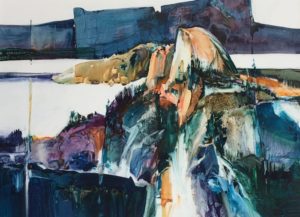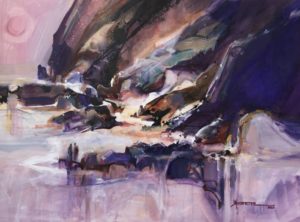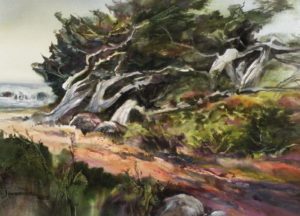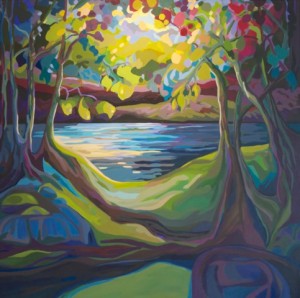Dear Artist,
After days of working en plein air, I’m realizing once more the compositional problems inherent in the real world. Vacillating, as most of us do, between the truth of reality and the compositional needs of the painting, in the field one tends to go for the truth.
That’s where a few days back in the studio can really pay off. The images developed on location are still fresh in the mind, but something else begins to happen. Composition improves.
One of the main problems in location work is the failure of pattern. Jane R. Hofstetter’s “Seven Keys to Great Paintings” starts right off emphasizing the early need for pattern. “If the basic shapes of a painting are not well designed and exciting,” she writes, “there is little purpose in continuing.”
Some things to think about:
It’s best to plan your pattern first, not after the fact.
Don’t be afraid to use thumbnail value plans as starters.
Think of the pattern as a structure that moves the eye.
The eye moves first to the simpler, larger shapes.
The overall pattern is best when it’s irregular and varied.
Avoid predictable shapes — blocks, circles, rectangles.
Avoid equality, kissing shapes and homeostatic effects.
Patterns should move beyond the periphery of the work.
The focal area can be more active, with smaller, sharper shapes.
Viewers’ eyes ask to be entertained — pattern is the opening act.
Patterns thrive in lights, darks, and plenty of middle tones.
Add mystery — shapes can be muzzy and obscure.
Yin and yang your pattern — alternate dark and light activity.
Squint at your work, invert it, or look at it in a mirror.
Your work should “read” from across the room.
If, in the early stages, your work is not turning out to have enough pattern, face it against the wall, or bury it and come back later. Very often the simple passage of time will give fresh keys to pattern improvement. As Don Quixote said to Sancho Panza after a particularly vexing passage: “Tomorrow will be another day.”
Best regards,
Robert
PS: “As you start your work
These words you’ll recall,
Make a pattern of shapes
Big, medium and small.” (Jane R. Hofstetter)
Esoterica: Canned reference is practically always loaded with problems. Photos, for example, contrive to kill imagination and stifle the natural development of creative patterns. While “ready-mades” do show up from time to time, they are rare. Art need not be what is seen — but what is to be seen. “Nature,” said James McNeill Whistler, “is usually wrong.”
This letter was originally published as “Patterns” on June 23, 2009.
Have you considered a Premium Artist Listing? With each letter, an artist is featured at the bottom of this page. The Premium Artist Listings are a means of connecting artist subscribers through their work. Proceeds from each listing contribute to the production of The Painter’s Keys.
“Seeing abstract value patterns, not just the literal subject, is one of the first and most difficult things for a growing artist to learn.” (Jane R. Hofstetter)
Featured Workshop
 Join Ellie Harold for “Intuitive Painting: Permission to Paint Expressively,” designed especially for mature women artists of all skill levels who wish to explore this medium for soulful exploration. The retreat provides attractive accommodations (your own room!) along with lightly structured activities for centering, relaxation and low stress art-making. You’ll have plenty of free time to muse, paint, write and reflect while enjoying the colors, textures and flavors of San Miguel. This Retreat has the potential to transform not only your art but your life! You’ll return home with a specific art “care plan” to assure support for further creating. Details at www.EllieHarold.com.
Join Ellie Harold for “Intuitive Painting: Permission to Paint Expressively,” designed especially for mature women artists of all skill levels who wish to explore this medium for soulful exploration. The retreat provides attractive accommodations (your own room!) along with lightly structured activities for centering, relaxation and low stress art-making. You’ll have plenty of free time to muse, paint, write and reflect while enjoying the colors, textures and flavors of San Miguel. This Retreat has the potential to transform not only your art but your life! You’ll return home with a specific art “care plan” to assure support for further creating. Details at www.EllieHarold.com.









12 Comments
Seeing abstract pattern is so important in painting but in landscape the challenge is to do this and also acknowledge space and distance and light.. and to capture the mood too. So a limited palette seems the way : no more than two primaries earth colours and white ..to focus. But oh I have left out the marks.. make them varied
All recipes in providing ingredients and the route from start to finish don’t usually include the character of the cook .. there lies magic
I recall long ago reading that everything in Nature is beautiful but isn’t always put it in the right place.
I recall, when this letter was originally published, a reader responded angrily to the quote about nature usually being wrong, asserting that it is always perfect and the writer is simply arrogant to think otherwise. I often thought about that response and how the responder didn’t get the point. Nature just is. The artist has the difficult task of rendering it in a compelling way within the confines of the picture plane.
Great letter, a reminder to go back and rethink things…
Hofstetter’s excellent book really changed the way I think about designing a painting. And I have never forgotten the words of the master watercolorist Frank Webb during a workshop: “Remember, God did not attend art school.” It’s up to us as artists to improve on reality. Otherwise, we’re just cameras.
Thank you so much for this informative letter and for the viewers excellent comments. So good to re-evaluate your personal work and look at it fresh from a different perspective.
I just took up watercolor after fifty years of painting in oils, acrylic, goache and printmaking. Wow, what a technically complex medium to master while still maintaining the inherent transparency and lightness of its essence! I’m finding preliminary sketching is invaluable, but not so much preplanned composition that the painting loses its originality and spontaneity. Not much dark either, so nowhere to hide. The artist who I’ve always loved in this medium is Lucy Willis, who has been painting watercolors for over forty years plein air all over the world and has many books of her work. She has the best advice and instruction since David Hockney taught me back in 1968 and said to go to art school in London.
Robert’s words about putting down the stroke and “leaving it there” (and not touching it!) really came back to me in my first mawkish attempts at watercolors. There are no “do overs”. I’m up to three smallish paintings a day, just practice, practice, practice.
“The birds they sing at break of day
begin again
I hear them say”
——Leonard Cohen.
When the beat drops in Sprunki Incredibox, it’s like the world stops for a second. Pure musical joy!
It’s fun to join the multiplayer arena.
Happy! Geometry Dash
Your perspective on the struggle between reality and composition feels incredibly true for anyone who paints outdoors. That constant adjustment between what we see and what the artwork needs is such a delicate process. By the way, during breaks I’ve been exploring little creative distractions like kirka.io unblocked, and even that reminds me how structure and improvisation go hand in hand.
You explained everything in a way that actually makes sense. Thank you!